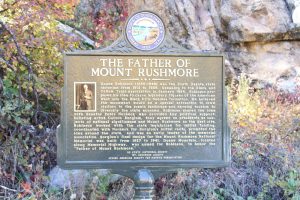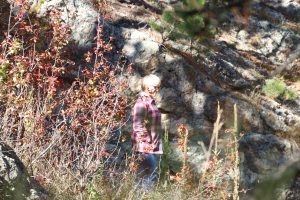After our brief visit to Mount Rushmore, we headed out to the head of Iron Mountain Road just east of the Memorial.
The last of the tourist drives that Peter Norbeck helped develop, Iron Mountain Road is more art form than transit. Like Needles Highway, Norbeck was instrumental in picking the route of the road in 1933 as Mount Rushmore was being carved. The route for the road was selected to provide a showcase approach to Mount Rushmore from Custer State Park. The road winds up to near the top of Iron Mountain and then down in it’s approach to Rushmore. Along the way, the road twists and turns through rich forests, around three “pig tail” bridges, and through three tunnels.
Driving the road in reverse, we found a small turn off just after going through the first tunnel. There was a historical marker at the location to honor Doane Robinson, who is considered the “father of Mount Rushmore”. We decided the spot was just right for a small picnic lunch and a chance to get out and enjoy solitude and beauty of the route, which was almost more enjoyable after the hustle and bustle of our visit to Mount Rushmore.




Just before leaving, I decided to go back to take a look through the tunnel that we had come through. I was pleasantly surprised to find that it provided a majestic frame for Mount Rushmore going in the other direction.

Refreshed with our light lunch, we continued our drive back to our campsite in Custer State park along the very scenic Iron Mountain Road.
If I were to do it again, I think I’d be tempted to do Iron Mountain Road in the opposite direction, watching for turnouts and places to stop and reflect on the inspiring significance of Mount Rushmore in the beauty of its natural setting in the Black Hills.
